Supermassive black holes are thought to be born from successive mergers of smaller black holes, each bringing with it angular momentum that accelerates the spin of the black hole they birth. Measuring the spin of supermassive black holes can therefore provide insight into their history – and a new study suggests a new way to make such inferences based on the effects of spinning black holes on the very fabric of space and time.
Whirling space-time and shattered stars help reveal how fast supermassive black holes spin. The “wobbling” remains of a star that died a gruesome death in the jaws of a supermassive black hole have helped reveal the speed at which its devourer spins, the journal Nature reports.
The doomed star at the centre of this study was torn apart by a supermassive black hole in what’s known as a tidal disruption event (TDE). These events begin when a star gets too close to the massive gravitational pull of a black hole. Once it’s close enough, huge tidal forces are generated inside the star, squashing it horizontally and stretching it vertically. This is called ‘spaghettification’, and it’s the process that turns the star into a strand of stellar paste – but, crucially, not all of it is gobbled up by the destructive black hole.
Some of this material is blown away, and some envelops the black hole, forming a flattened cloud called an accretion disk. Not only does this accretion disk gradually feed the central black hole, but the same tidal forces that initially tore apart the star also cause enormous frictional forces that heat up this plate of gas and dust, causing it to glow brightly.

Illustration showing a spinning supermassive black hole surrounded by the debris of a dead star and dragging spacetime along with it (green grid)
Moreover, as supermassive black holes spin, they tug the fabric of spacetime itself (the four-dimensional unity of space and time) with them. This “Lense-Thirring” effect, or “frame-dragging effect,” means that nothing stands still at the edge of a spinning supermassive black hole. The effect also causes a brief “wobble” in the black hole’s newly formed accretion disk.
The team found that the “wobble” of this accretion disk can be used to determine the rotation speed of the central black hole. The frame-dragging effect is present in all rotating black holes. If the disruptive black hole is rotating, then the flow of stellar debris onto the black hole after the TDE is subject to this effect.
To study the TDE and drag the frames, the team spent five years searching for bright, relatively nearby examples of black hole-driven stellar disruption that could be quickly tracked. The goal was to detect signs of accretion disk precession caused by the Lense-Thirring effect.
In February 2020, that search was successful. The team was able to detect AT2020ocn, a bright flash of light coming from a galaxy located about a billion light years away. AT2020ocn was initially detected at optical wavelengths by the Zwicky Transient Facility, with these visible-light data indicating that the emission came from a TDE involving a supermassive black hole with a mass between 1 million and 10 million solar masses.
Due to the Lense-Thirring effect, the X-rays coming from the newly formed hot accretion disk precess or “wobble.” This shows up as X-ray modulations in the data. However, after a while, as the accretion rate drops, gravity forces the disk to align with the black hole, at which point the wobble and X-ray modulations stop.

An illustration of a black hole tearing apart a star in a tidal disruption event. The image shows a rotating black hole dragging spacetime with it. ESA/C. Carreau/ Robert Lea
The TDE that launched AT2020ocn could be an ideal event to search for Lense-Thirring precession, and since this type of wobble is only present in the early stages of accretion disk formation, they had to act quickly.
The only way to observe is once a tidal disruption occurs, you have to have a telescope looking at that object continuously for a very long time, to study all sorts of time scales, from minutes to months.
That’s where NASA’s Neutron Star Interior Composition ExploreR (NICER) comes in: an X-ray telescope located on the International Space Station (ISS) that measures X-rays around black holes and other ultra-dense, compact massive objects like neutron stars. The team found that not only was NICER able to catch the TDE, but the ISS-mounted X-ray telescope was also able to continuously monitor the event as it unfolded over several months.
The X-ray brightness and temperature of the X-ray emitting region after a TDE are modulated on a time scale of 15 days. This repeating 15-day X-ray signal disappears after three months.
The results of the study also presented a surprise.
Estimates of the mass of the black hole and the mass of the destroyed star showed that the black hole is not spinning as fast as expected. The black hole is not spinning that fast – only less than 25% of the speed of light.
The hunt for TDEs is expected to have a bright future thanks to the Vera C. Rubin Observatory, currently under construction in northern Chile, which will conduct a 10-year study of the universe called the Legacy Survey of Space and Time (LSST). Rubin will detect thousands of TDEs over the next decade. If we can measure the Lense-Thirring precession of even a small fraction of them, we can say something about the spin distribution of supermassive black holes, which relates to how they have evolved over the age of the universe.
Elusive mid-sized black holes may form in dense “birthing nests.” Modeling has shown that black holes with masses between 100 and 10,000 times that of the Sun may be born in a chaotic chain of stellar collisions, the journal Science reports.
Researchers have found that the elusive intermediate-mass black holes can form in dense star clusters containing tens of thousands to millions of tightly packed stars called “globular clusters.”
An intermediate-mass black hole has a mass between 100 and 10,000 times that of the Sun. They are heavier than solar-mass black holes, which have a mass between 10 and 100 times that of the Sun, but lighter than supermassive black holes, which have a mass equivalent to millions or even billions of Suns.
These cosmic intermediary objects have proven elusive to astronomers, with the first example discovered in 2012. Designated GCIRS 13E, it has a mass 1,300 times that of the Sun and is located 26,000 light-years away, toward the Milky Way’s galactic center.
One of the mysteries surrounding intermediate-mass black holes concerns their formation. Stellar-mass black holes are born when massive stars collapse, and supermassive black holes grow from subsequent mergers of increasingly larger black holes. However, a star massive enough to die and create a black hole with thousands of solar masses must be incredibly rare, and must struggle to retain that mass when it “dies.”
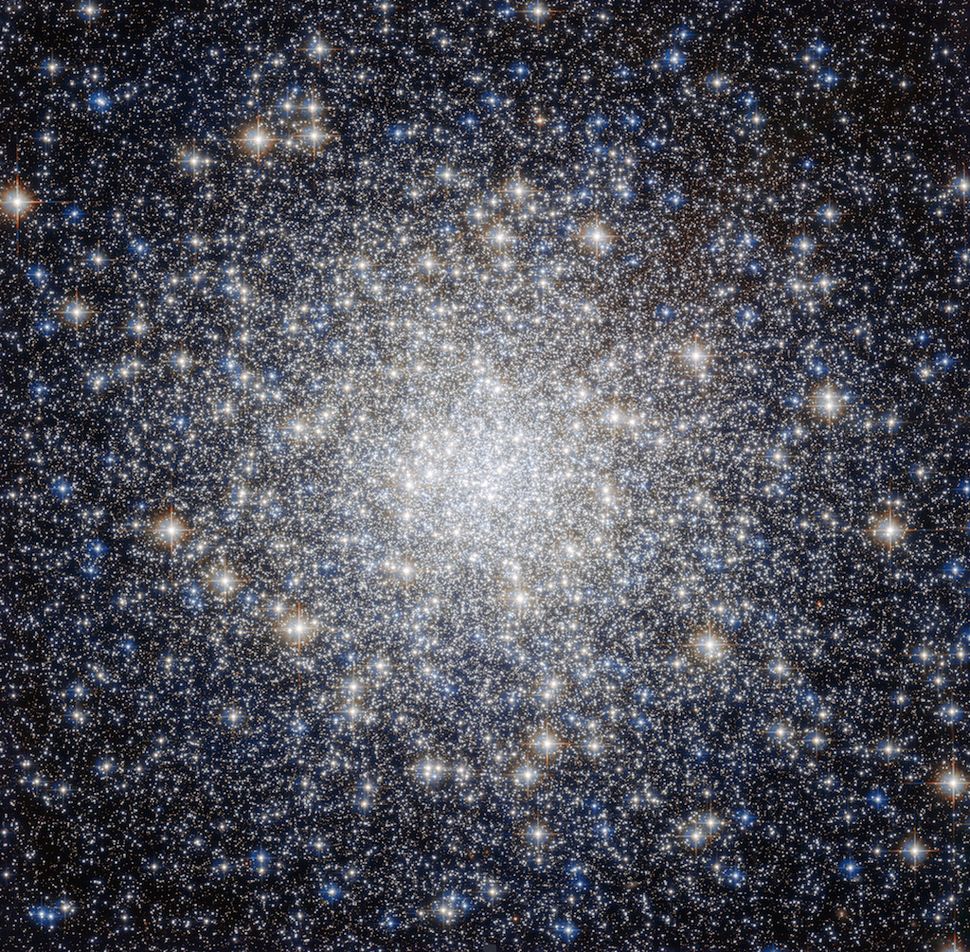
The globular cluster Messier 92, located 27,000 light-years away in the constellation Hercules. ESA/NASA/Hubble
To explore the mystery of how these intermediate-mass black holes form, a team of researchers conducted the first-ever stellar simulation of massive clusters. This showed that a sufficiently dense molecular cloud, the “birth nest” of globular clusters, can create stars massive enough to collapse and produce an intermediate-mass black hole.
“Previous observations suggested that some massive star clusters, globular clusters, contain an intermediate-mass black hole,” team leader and University of Tokyo scientist Michiko Fujii said in a statement. “Until now, there was no convincing theoretical evidence to support the existence of an intermediate-mass black hole, with a mass between 1,000 and 10,000 solar masses, compared to less massive (stellar mass) and more massive (supermassive) ones.”
The term “birthing nest” may well evoke images and feelings of warmth, comfort and tranquility, but it could not be less appropriate to describe star formation in globular clusters. These tightly packed conglomerates of stars live in chaos and confusion, with differences in density causing stars to collide and merge. This process causes the stars to accumulate mass, thereby increasing their gravitational influence, pulling more stars into their vicinity and causing more and more mergers.
The runaway collisions and mergers that occur in the cores of globular clusters can create stars with masses equivalent to about 1,000 suns. That’s enough mass to create an intermediate-mass black hole, but there’s a catch.
Astrophysicists know that when stars collapse to form black holes, much of their mass is carried away in supernova explosions or stellar winds. Previous simulations of the formation of intermediate-mass black holes have confirmed this, further suggesting that even massive stars with masses of 1,000 solar masses would be too small to create an intermediate-mass black hole.
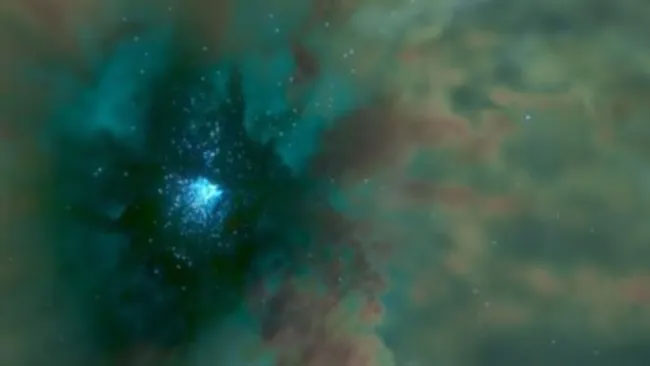
A supercomputer simulation image shows the formation of a tar cluster in a giant molecular cloud. Michiko Fujii and Takaaki Takeda, 2024.
To find out whether a massive star can “survive” with enough mass to give rise to an intermediate-mass black hole, Fujii and his team simulated a globular cluster as it formed.
“We successfully conducted the first numerical simulation of globular cluster formation by modeling individual stars,” Fujii said. “By resolving individual stars with realistic masses for each, we were able to reconstruct stellar collisions in a densely packed environment. For these simulations, we developed a new modeling code in which we could integrate millions of stars with high accuracy.”
In the simulated globular cluster, runaway collisions and mergers led to the formation of extremely massive stars that were able to retain enough mass to collapse and produce an intermediate-mass black hole.
The team also found that the simulation predicted the mass ratio between the intermediate-mass black hole and the globular cluster in which it formed, a ratio that turned out to match actual astronomical observations.
“Our ultimate goal is to simulate entire galaxies,” Fujii explained. “It is still difficult to simulate Milky Way-sized galaxies by studying individual stars using currently available supercomputers. However, it might be possible to simulate smaller galaxies, such as dwarf galaxies.”
Fujii and her team also intend to target star clusters that formed in the early universe. “The first clusters are also places where intermediate-mass black holes can be born,” she said.
Do stars disappear into their own black holes? Scientists have found compelling evidence that some massive stars end their lives by plunging into the black hole they created, without the light and fury of a supernova, the journal Physical Review Letters reports.
Stars generate energy through nuclear fusion processes in their cores, where they convert hydrogen into helium. When stars at least eight times the mass of our Sun run out of this supply of hydrogen, they begin fusion reactions involving other elements – helium, carbon, oxygen and so on – until they have an inert core of iron, which requires more energy to fuse than it can produce. At this point, the fusion reactions stop and the energy production that holds the star together evaporates. Suddenly, gravity takes over and causes the core to collapse, while the outer layers of the star bounce off the contracting core and explode outwards – forming a supernova that can sometimes shine brighter than an entire galaxy for a few weeks.
Meanwhile, the collapsing core forms a compact object. This object is often a spinning neutron star called a pulsar, but under certain conditions it could be a stellar-mass black hole. This is the standard story of stellar timelines. However, astronomers are now beginning to think that some stars that produce black holes can do so without going supernova.
Researchers have occasionally noticed cases of failed supernovae – stars that start out glowing as if they are about to explode, but then fade and die away. Elsewhere, studies of old photographic plates by the VASCO (Vanishing and Appearing Objects over a Century of Observations) project, led by Beatriz Villarroel, have found dozens of stars on these old plates that are simply no longer visible; it is as if they have vanished without a trace.
Could these failed supernovas and vanishing stars be evidence that stars are almost completely sucked into the black hole they form before they have a chance to explode? Well, maybe, some scientists think.
“If one were to stand and watch a visible star undergoing a complete collapse, it would appear, at just the right moment, as if the star were suddenly extinguished and vanished from the sky,” said Alejandro Viña-Gomez of the Max Planck Institute for Astrophysics in Germany in a statement. “Astronomers have indeed observed bright stars suddenly disappearing in recent times.”

An artist’s impression of VFTS 243, which contains a massive star and a black hole. ESO/L. Calçada
While the idea remains just a theory for now, it now has some hard evidence to back it up in the form of a strange binary system studied by Viña-Gómez and his team. The system, designated VFTS 243, was discovered in 2022 and is located in the Tarantula Nebula, which is located in the Large Magellanic Cloud; it contains a 25-solar-mass star and a 10-solar-mass black hole that must have been created by a massive star that reached the end of its life relatively recently, in cosmic terms.
“VFTS 243 is an unusual system,” said Viña-Gómez. “Even though VFTS 243 contains a star that collapsed into a black hole, there is no evidence of the explosion anywhere.”
For example, the orbits of the star and black hole in VFTS 243 around their common center of mass are still nearly circular. However, supernova explosions are asymmetrical, with slightly more energy released in one direction than the other, which should give the compact object a “natal kick.” Such a kick would accelerate the compact object, causing its orbit to widen and become more elongated. Typically, this kick is between 30 and 100 kilometers (19 and 62 miles) per second, but the black hole in VFTS 243 received, at most, a kick of only four kilometers (2.5 miles) per second.
The aftermath of natal shocks has been observed before in pulsars, but never before in stellar-mass black holes. It’s possible that this tells us something about how stellar-mass black holes form, and VFTS 243 is the clearest look yet at the results of this process.
Birth shocks are the result of three things: the ejection of debris from the exploding star, the ejection of neutrinos from the collapsing core of the star, and gravitational waves. However, if there were no supernova, there would be no debris, only neutrinos and gravitational waves, which provide a much smaller kick – which is what we see in VFTS 243.
If true, this would mean that many of the most massive stars in the universe, which shine so brightly, end their lives in silent darkness as they are sucked into oblivion by a black hole. This could also be the final fate of the surviving star in VFTS 243 when it reaches the end of its life.
There are broader implications, too. A supernova explosion is an elemental factory. Not only are elements like oxygen, carbon, and nitrogen from the dying star’s outer layers blasted into space, where they can be recycled into the next generation of stars and planets, but the intense heat and energy of a supernova’s shock wave can cause even heavier elements to form in the supernova’s debris. For example, one of the reasons supernovae shine so brightly and for so long is that the radioactive decay of nickel isotopes produced in the explosion leads to the formation of cobalt and iron.
However, if some massive stars collapse completely into black holes without exploding as supernovae, they cannot contribute to the creation and recycling of elements. So cosmochemists will need to incorporate this concept, if it is indeed correct, into their models of how elements are formed and distributed through space. Only then can they begin to fully understand the chemical evolution of galaxies, including our own, and how quickly the necessary elements can accumulate to form planets like Earth, perhaps even with life of their own, created from elements produced by exploding stars.
Scientists have confirmed for the first time that the fabric of space-time itself takes a “final leap” at the edge of a black hole. The observation of this fast-moving region around black holes was carried out by astrophysicists from the University of Oxford’s Department of Physics and helped confirm a key prediction of Albert Einstein’s 1915 theory of gravity: general relativity, the journal Monthly Notices of the Royal Astronomical Society reports.
The Oxford team made the discovery by focusing on regions surrounding stellar-mass black holes in binary systems with companion stars located relatively close to Earth. The researchers used X-ray data collected from a variety of space telescopes, including NASA’s Nuclear Spectroscopic Telescope Array (NuSTAR) and the International Space Station’s Neutron Star Interior Composition Explorer (NICER).
These data allowed them to determine the fate of hot, ionized gas and plasma torn away from the companion star, which last dove at the very edge of its associated black hole. The results showed that these diving regions around the black hole are the locations of some of the strongest points of gravitational influence ever observed in our Milky Way galaxy.
“This is the first glimpse of plasma stripped from the outer edge of a star undergoing its final fall into the centre of a black hole, a process that occurs in a system about 10,000 light years away,” team leader and University of Oxford physicist Andrew Mummery said in a statement. “Einstein’s theory predicted that this final fall would take place, but this is the first time we have been able to demonstrate that it happens.”
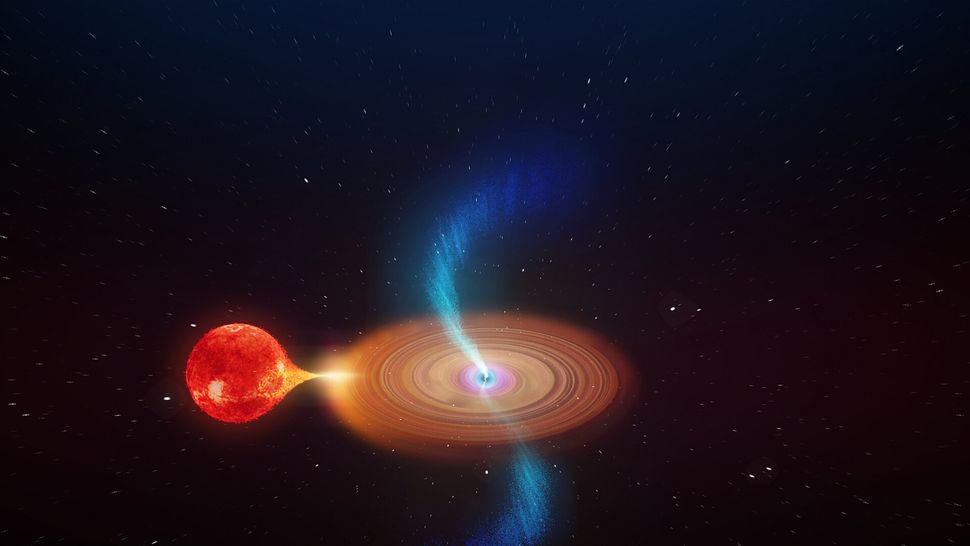
The “normal” star is in a binary system with a black hole, the mass of which goes from the first to the second. ICRAR
“Imagine the river turning into a waterfall – until now we’ve been looking at the river. This is our first glimpse of a waterfall.”
Einstein’s general theory of relativity suggests that objects with mass cause the very fabric of space and time, which is combined into a single four-dimensional entity called “spacetime,” to curve. Gravity arises from the resulting curvature.
Although general relativity works in 4D, it can be vaguely illustrated with a crude 2D analogy. Imagine placing spheres of increasing mass on a stretched rubber sheet. A golf ball will leave a tiny, almost unnoticeable dent; a cricket ball will leave a large dent; and a bowling ball will leave a huge dent. This is analogous to the way moons, planets, and stars “dent” 4D spacetime. As an object’s mass increases, so does the curvature they cause, and thus their gravitational influence. A black hole would be like a cannonball on this analogous rubber sheet.
With masses equivalent to tens or even hundreds of suns squeezed wide around the Earth, the curvature of spacetime and the gravitational influence of stellar-mass black holes can become quite extreme. Supermassive black holes, on the other hand, are a different story. They are extremely massive, with masses equivalent to millions or even billions of suns, dwarfing even their stellar-mass counterparts.
Returning to general relativity, Einstein proposed that this curvature of space-time leads to other interesting physics. For example, he said, there must be a point just outside the black hole where particles will not be able to follow a circular or stable orbit. Instead, matter that falls into this region will rush toward the black hole at close to the speed of light.
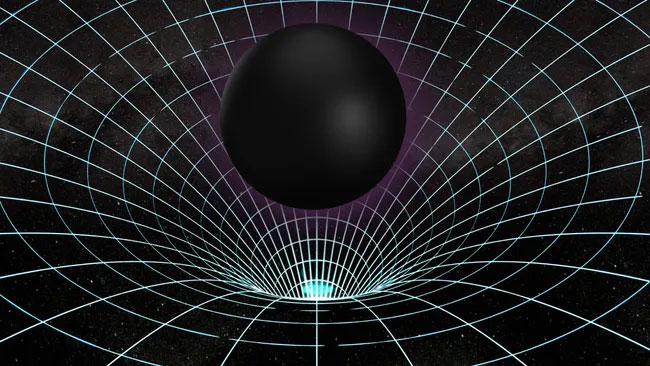
Illustration showing a black hole causing a “plunging” warp in space-time. Robert Lee
Understanding the physics of matter in this hypothetical black hole’s sinking region has been a goal of astrophysicists for some time. To address this, the Oxford team looked at what happens when black holes exist in a binary system with a “normal” star.
If the two stars are close enough, or if the star is slightly bloated, the gravitational pull of the black hole can pull in stellar material. Because this plasma has angular momentum, it can’t fall directly onto the black hole — so instead it forms a flattened, rotating cloud around the black hole called an accretion disk.
From this accretion disk, matter gradually flows into the black hole. According to models of black hole feeding, there must be a point called the inner stable circular orbit (ISCO) – the last point at which matter can remain stably orbiting in the accretion disk. Any matter beyond this is in the “dip region”, and it begins its inevitable descent into the black hole’s mouth. The debate over whether this dip region could ever be detected was settled when the Oxford team detected emissions from the ISCO of accretion disks around a Milky Way binary black hole called MAXI J1820+070.
Located about 10,000 light-years from Earth and with a mass of about eight suns, the black hole that is a component of MAXI J1820+070 is pulling material from its stellar companion, simultaneously ejecting two jets at about 80% the speed of light; it also produces strong X-rays.
The team found that the X-ray spectrum of MAXI J1820+070 is in a “soft state” of outburst, which is emission from the accretion disk surrounding the rotating Kerr black hole – the entire accretion disk, including the immersion region.
The researchers say this scenario represents the first reliable detection of radiation from a sinking region at the inner edge of a black hole’s accretion disk; they call such signals “intra-ISCO emissions.” These intra-ISCO emissions confirm the accuracy of general relativity in describing the regions immediately surrounding black holes.
To take this research further, a separate team from Oxford’s Department of Physics is collaborating with the European initiative to build the African Millimeter Telescope. This telescope is designed to improve scientists’ ability to directly image black holes and to probe the sinking regions of more distant black holes.
“What’s really exciting is that there are a lot of black holes in the galaxy, and we now have a powerful new method for using them to study the strongest known gravitational fields,” Mummery concluded.
Physicists consider black holes to be some of the most mysterious objects that exist. Ironically, they are also considered to be some of the simplest. For years, physicists have tried to prove that black holes are more complex than they appear.
Research from the 1970s shows that you can describe a black hole comprehensively using just three physical attributes – their mass, charge and spin. All other properties of these massive dying stars, such as their detailed composition, density and temperature profiles, disappear when they collapse into a black hole. That’s how simple they are.
The idea that black holes have only three attributes is called the “no hair” theorem, meaning that they don’t have any of the “hairy” details that make them complex.
For decades, researchers in the astrophysics community have used loopholes or workarounds within the assumptions of the no-hair theorem to come up with potential hairy black hole scenarios. A hairy black hole has a physical property that scientists can measure — in principle — that goes beyond its mass, charge, or spin. This property must be a constant part of its structure.
About a decade ago, Stefanos Aretakis, a physicist now at the University of Toronto, showed mathematically that a black hole containing the maximum charge it can hold—called an extremely charged black hole—will develop “hair” on its horizon. A black hole’s horizon is the boundary beyond which nothing that crosses it, not even light, can escape.
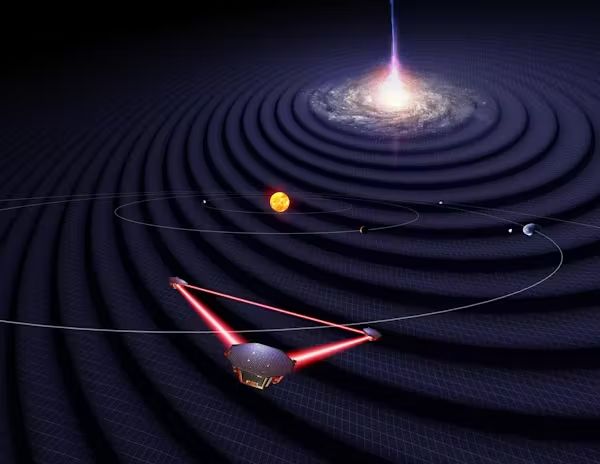
The LISA spacecraft observe gravitational waves from a distant source as they orbit the Sun. Simon Bark/University of Florida, CC BY
Aretakis’ analysis was more of a thought experiment using a highly simplified physics scenario, so it’s not something scientists would expect to see astrophysically. But supercharged black holes may not be the only kind that can have hair.
Since astrophysical objects such as stars and planets are known to rotate, scientists expect black holes to also rotate based on how they form. Astronomical evidence has shown that black holes do indeed have spin, although researchers do not know what the typical spin value is for an astrophysical black hole.
A gravitational wave is a tiny disturbance in space-time, usually caused by violent astrophysical events in the universe. Collisions of compact astrophysical objects, such as black holes and neutron stars, emit strong gravitational waves. An international network of gravitational observatories, including the Laser Interferometer Gravitational-Wave Observatory in the United States, regularly detects these waves.
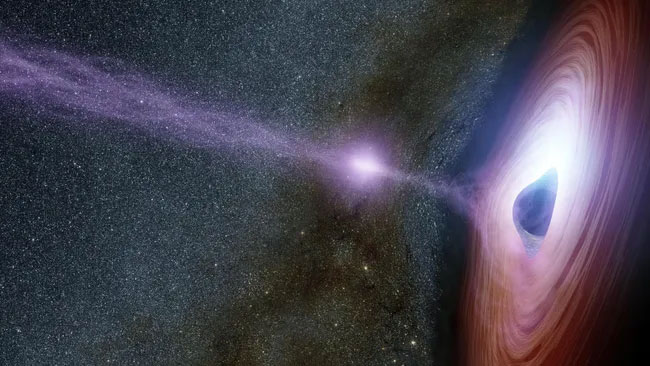
Illustration of a supermassive black hole. NASA/JPL
In January 2024, the European Space Agency officially accepted the LISA (Laser Interferometer Space Antenna) mission, which will search for gravitational waves. The launch is scheduled for 2035. LISA consists of three spacecraft configured in a perfect equilateral triangle that will follow the Earth around the Sun. The spacecraft will be 1.6 million miles (2.5 million kilometers) apart, and they will exchange laser beams to measure the distance between each other to within a billionth of an inch.
LISA will detect gravitational waves from supermassive black holes, which are millions or even billions of times more massive than our Sun. It will map spacetime around spinning black holes, helping physicists understand how gravity works in the immediate vicinity of black holes with unprecedented precision. Physicists hope that LISA will also be able to measure any hairy attributes black holes may have.
Have you ever wondered what happens when you fall into a black hole? Now, thanks to a breathtaking new visualization created on a NASA supercomputer, viewers can dive into a black hole’s event horizon, the point of no return.
“People ask this a lot, and modeling these hard-to-imagine processes helps me connect the mathematics of relativity to real-world consequences in the real universe,” said Jeremy Schnittman, an astrophysicist at NASA’s Goddard Space Flight Center in Greenbelt, Maryland, who created the visualizations. “So I modeled two different scenarios: one in which the camera — a stand-in for the brave astronaut — simply misses the event horizon and bounces back, and one in which it crosses the boundary, sealing its fate.”
The visualizations come in several forms. Explainer videos act as tour guides, highlighting the strange effects of Einstein’s general theory of relativity. Versions presented as 360-degree videos allow viewers to look around as they travel, while others play as flat maps of the entire sky.
To create the visualizations, Schnittman teamed up with fellow Goddard scientist Brian Powell and used the Discover supercomputer at NASA’s Climate Modeling Center. The project generated about 10 terabytes of data—equivalent to about half the estimated text content in the Library of Congress—and took about five days to run on just 0.3% of Discover’s 129,000 processors. The same feat would take a typical laptop more than a decade.
The target is a supermassive black hole with a mass 4.3 million times that of our Sun, equivalent to the monster at the center of our Milky Way galaxy.
“If you have a choice, you want to fall into a supermassive black hole,” Schnittman explained. “Stellar-mass black holes, which contain up to 30 solar masses, have much smaller event horizons and stronger tidal forces that can tear apart incoming objects before they reach the horizon.”
This happens because the gravitational pull on the end of the object closest to the black hole is much stronger than on the other end. Falling objects are stretched like noodles, a process astrophysicists call spaghettification.
The event horizon of the simulated black hole spans about 16 million miles (25 million kilometers), or about 17% of the distance from Earth to the sun. A flat, swirling cloud of hot, glowing gas called an accretion disk surrounds it and serves as a visual reference as it falls. So do glowing structures called photon rings, which form closer to the black hole from light that has orbited it once or more times. The backdrop of the starry sky as seen from Earth completes the scene.
As the camera approaches the black hole, reaching increasingly close to the speed of light, the glow of the accretion disk and background stars intensifies, much like the sound of an approaching race car becomes higher in pitch. Their light appears brighter and whiter when viewed in the direction of travel.
The films begin with the camera positioned nearly 400 million miles (640 million kilometers) away, and the black hole quickly fills the field of view. Along the way, the black hole’s disk, photon rings, and night sky become increasingly distorted — and even form multiple images as its light traverses increasingly curved spacetime.
In real time, the camera takes about 3 hours to fall to the event horizon, making almost two full 30-minute orbits along the way. But to anyone watching from far away, it never gets there. Because spacetime becomes increasingly distorted closer to the horizon, the camera’s view slows down and then appears to freeze right in front of it. That’s why astronomers originally called black holes “frozen stars.”
At the event horizon, even space-time itself flows inward at the speed of light, the cosmic speed limit. Once inside, both the camera and the space-time it moves through are rushing toward the center of the black hole—a one-dimensional point called a singularity, where the laws of physics as we know them cease to apply.
“Once the camera crosses the horizon, its destruction by spaghettification occurs in just 12.8 seconds,” Schnittman said. From there, the singularity is only 79,500 miles (128,000 kilometers) away. This final leg of the journey is over in the blink of an eye.
In the alternative scenario, the camera orbits close to the event horizon, but never crosses it or escapes to safety. If an astronaut were to pilot a spacecraft on this 6-hour round trip while her colleagues in the mothership remained far from the black hole, she would return 36 minutes younger than her colleagues. This is because time flows more slowly near a strong gravitational source and when traveling close to the speed of light.




